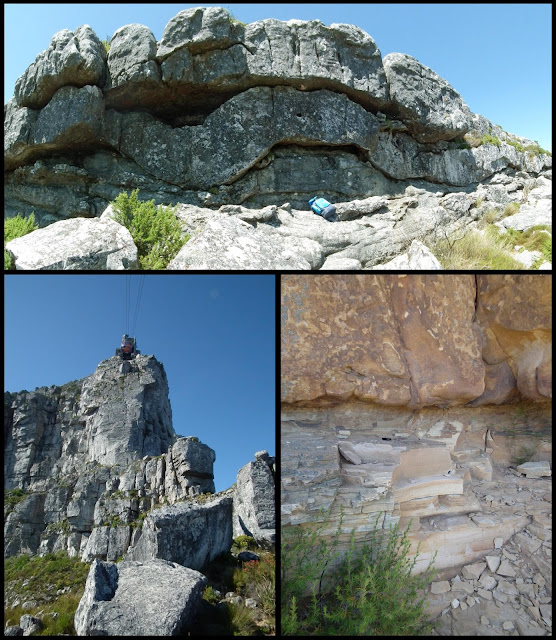If you are attending the 35th International Geological Congress meeting in Cape Town this year (or if you are ever in the Mother City), you will undoubtedly stand in awe of the city's most iconic feature - Table Mountain. You may then even decide to venture up the mountain, either by hiking up or by using the famous cable car. If you are so inclined, you may often gaze upon the immense beauty of the Fynbos vegetation. These characteristic shrubs are of world acclaim, accounting for more than 20% of endemic plant species on the African continent. No wonder that this region has been established as a World Heritage Site. You may also occasionally look upon the rocks and wonder about their history. Well, you're in luck: below is a brief overview of the geology of Table Mountain and a geological map for your pleasure!
Some examples of the Fynbos on Table Mountain. Geophyte (Watsonia) top left, Ericas (Red Heath) right and Aster (bottom left).
The rocks making up Table Mountain fall largely within the Table Mountain Group, which further falls within the Cape Supergroup. The Table Mountain rocks are clastic sedimentary rocks that were deposited in an evolving braided stream - lagoon - beach environment. This evolution is defined by continuous fluctuations of sea-level and sedimentary transport styles over millions of years, with these rocks being deposited between ca. 500-450 million years ago. Look carefully at the variation in the rock texture, grain size and even evidence of depositional orientations.
Glacial deformation in the Pakhuis (top), Peninsula large quartzite boulders and cliff faces (bottom left), Graafwater fine-grained sandstone (bottom right).
The lowermost rocks that you will encounter on Table Mountain are thin reddish-maroon siltstone, fine-grained sandstone and light brown to purple sandstone of the Graafwater Formation. These were formed in a tidal flat estuarine environment and have an abundance of various sedimentary features and trace fossils - how many can you spot?
Overlying the Graafwater are the pebble-rich quartzite and quartz arenites of the Peninsula Formation. These well bedded grey rocks comprise much of the steep cliff faces of Table Mountain and formed as a braided fluvial system depositing along the subtidal continental shelf.
If you still have some energy upon reaching the top of Table Mountain and would like to experience an ice-age proportional climatic shift, then do continue toward Maclear's Beacon. As you approach this famous landmark you may notice the large and rounded outcrops of the Pakhuis Tillite. These immature rocks consist of glacial diamictite with faceted and striated quartz pebbles, which were deposited during a 35 million year long ice-age during the upper Ordovician period. Can you spot any glacially-driven deformation in these rocks?



